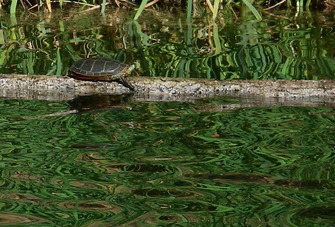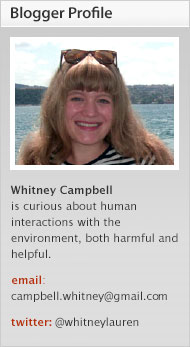« Prev Next »

In science courses at school, I learned that "green" corresponded to a wavelength of about 520-570 nanometres. Green became the medial color of the visible spectrum, the central band in the rainbow, the middle initial of Roy G. Biv. In art class, I discovered firsthand that green paint wasn't a primary color of the subtractive palette, but a mixture of yellow and blue paints. My understanding of green matured in physics, when I encountered the additive palette (RGB) and saw green light as a constitutive primary along with blue and red.
During this time as a student, I also started to think of green as meaning "environmental " or "sustainable." In college, "green" became a catch-all term for any ecological endeavor: green energy, green architecture, green societies. The thesaurus of my word processor now reflects this, offering synonyms of "conservational," "recyclable," "eco-friendly" and "ecologically aware" for "green." Reflecting on this usage for this post made me wonder when green first appropriated this meaning. When exactly did people start calling sustainable behaviors and practices "green?"
From what I've since read, it seems that the widespread usage of "green" as "environmental" originated with the then-named Don't Make A Wave Committee. The group organized during the 1960s to oppose US nuclear weapons testing on the tectonically fragile island of Amchitka off the coast of Alaska. Wary of tsunamis and ecological damage, the group was shook into action by plans to detonate a 5.1 megaton nuclear bomb named Cannikin 5,875 feet below the island's surface. Referring to this event as "insane ecological vandalism," the Don't Make A Wave Committee decided to charter a boat to Alaska to witness the explosion's impact.
According to one of the founders, at the close of a meeting about these plans, a committee member flashed a "V" hand sign to the group and said "peace." Another member then said, "Make it green peace." As it linked nuclear disarmament with ecology, the group decided to christen the boat Greenpeace, and soon after, they renamed the organization itself.1 After Greenpeace sailed to Amchitka, media attention and public criticism of the testing intensified, but when the US Supreme Court ruled in its favor, the government went through with its plans. The Cannikin shockwave registered as the largest ever human-made tremor, 7.2 on the Richter Scale, which created a thirty-acre crater, drained six natural lakes, and killed thousands of seabirds and otters.2 The mission wasn't a failure, though, as the actions of Greenpeace and other conservationists pressured the US to subsequently shut down the nuclear testing program in Alaska.
But while I found out that this year — 1971 — is when "green" first began to signify the attitudes found here and at Green Science, I couldn't help but think that the word somehow meant "environmental" at a more fundamental level. So after learning the Greenpeace story, I finally decided to go to the dictionary, the place most word queries begin. As it turns out, "green" is related to the Old English "grēne," a modification of the Old High German "grün," the adjective form of the verb "growan," or "to grow. "
The association of green with the environment then seems to be as natural as could be.
Photo Credit: Washington State Department of Ecology
1. Weyler, R. Greenpeace: How a Group of Journalists, Ecologists, and Visionaries Changed the World. Vancouver: Raincoast Books, 2004.
2. Kohlhoff, D. Amchitka and the Bomb: Nuclear Testing in Alaska. Seattle: University of Washington Press, 2002.























http://www.nature.com/scitable/spotlight/solar-energy-8731061